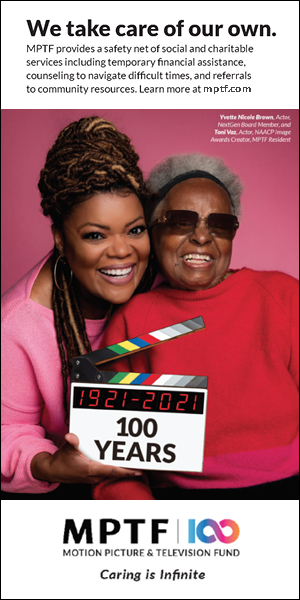DGA also issues first-time inclusion report on Assistant Directors/Unit Production Managers in dramatic television.
LOS ANGELES – Even with a significant reduction in the number of television episodes directed during the Covid-19 pandemic, the percentage of dramatic television episodes directed by women and directors of color continued to increase. 34% of dramatic television episodes in the 2020-21 season were helmed by directors of color, and 38% were directed by women, the Directors Guild of America announced today in its latest Episodic Television Director Inclusion Report.
There were 2,691 DGA-covered episodes in the 2020-2021 season, a reduction of 36% from 4,186 episodes in the 2019-20 season. Despite the significant decline in overall episodes, gains in diversity by percentage of episodes directed continued year over year.
While the shares of episodes directed by women and directors of color continued to see incremental growth, gains were not evenly shared. Latino and Asian directors saw minimal gains, continuing to remain underrepresented at 9% and 7% respectively.
“When the pandemic hit, a big question on our minds was whether progress on inclusive hiring would backslide as the production environment changed radically with the implementation of necessary COVID Safety Protocols,” said DGA President Lesli Linka Glatter. “Despite all the production challenges, the good news is that inclusive hiring continued its upward climb last year – both in overall hiring, as well as hiring of first-time directors. That said – although there has been continued progress, the goal of a level playing field for all has not yet been achieved. In addition, the statistics clearly reveal this, especially for our Latino and Asian members”
The DGA issued its first-ever inclusion report on the other members of the directorial team (UPMs, First ADs, Second ADs) in dramatic television revealing that women represented 39% of members employed in full-season series positions and directorial team members of color represented 24% of the directorial team employed in full-season series positions.
“We are proud to be issuing our first-ever inclusion report of the directorial teams in episodic television,” said Glatter. “By focusing on full-season hires – we have been able to create an important new baseline of current studio hiring practices for the directorial team. Unfortunately, this report reveals that the studio hiring practices for the directorial team raises areas of concern, particularly regarding the hiring of ADs and UPMs of color who represent less than one-fourth of all team members hired last season.”
Episodes Directed / Hiring Breakdown
Of the approximately 2,700 episodes produced in the 2020-21 season, the portion helmed by directors of color increased by 5 percentage points to 34%, up from 29% the prior season and more than doubled from just 16% since 2014. Episodes directed by women increased by 3 percentage points to 38%, up from 35% the prior season and more than doubling from 16% since 2014.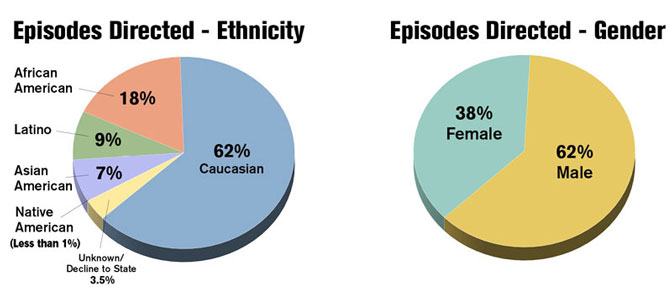
Breaking down the data, in the 2020-21 season:
- 38% of episodes were directed by women, up from 35% the prior season
- 18% of episodes were directed by African Americans, up from 15%[1]
- 9% of episodes were directed by Latinos, up from 7%
- 7% of episodes were directed by Asian Americans, flat with the prior season
- Less than 1% of episodes were directed by Native Americans, flat with the prior season
A further breakdown by ethnicity and gender can be found in Appendix A.
Analysis & Ranking of Television Studios [2]
The major studios oversaw the production of nearly three-quarters of the episodes covered in this report. Their hiring records follow.

Companies that oversaw the production of fewer than 70 episodes were not included in the above ranking, as hiring patterns were less conclusive since a few episodes or a single series could swing percentages far into one direction or another. The most recognizable of those studios that were not included in the ranking were Lionsgate, Amazon and Viacom.
Hiring data by individual series can be found in Appendix B:
First-Time Episodic Television Directors
Recognizing that inclusion cannot truly be achieved until the pipeline changes, the DGA has been tracking and reporting publicly on trends in first-time TV director hires for over a decade.
As part of that reporting, the DGA has also been closely monitoring for many years the numbers of first-break jobs given to those affiliated with the series in another capacity, predominantly writer/producers and actors vs. those given to individuals who were hired for their experience as directors working in other genres such as features and commercials, referred to below as ‘career-track directors.’
In the 2020-21 season which was affected by the pandemic, employers hired 113 directors who had never directed episodic television for the 2,691 episodes directed.
Overall, the percentage of these first breaks going to directors of color grew to 39% (up from 30% last year), while the portion going to women was 46%, down 1% from last year’s 47%.
Seventy-two (64%) first break jobs were given to directors affiliated with the show and 41 (36%) jobs were given to career-track directors. The pools of career-track directors and affiliated hires differ in terms of diversity – with the pool of career-track directors having higher percentages of people of color and women than affiliated hires. Women represent 55% of career-track director hires vs. 40% of affiliated directors. 44% of directors of color are career-track directors while 38% are affiliated with the show.
These inclusion differences are important because as DGA data complied since 2009 shows, two-thirds of career-track directors continue on to direct on another series, where only 25% of affiliated directors went on to direct for a series with which they had no affiliation.
Episodic Directorial Team Report 2020-2021
For the first time, the DGA has created a report about the status of inclusion in the director’s team in dramatic television based on full-season hires and not individuals hired for just a day or few days on an individual episode.
In the 2020-21 season, there were 170 DGA-covered U.S.-based scripted TV series. The DGA’s analysis included episode lengths up to 60 minutes in both single camera and multi-camera scripted series. The report includes programs made for SVOD, Pay Television, Network and Basic Cable and excludes pilots.
For the purposes of analysis – a single job was defined as follows: a crew hire in a work category of UPM (Unit Production Manager), 1AD (First Assistant Director), Key 2AD (Second Assistant Director), Second 2AD (Second Second Assistant Director), Additional 2AD (Additional Second Assistant Director), and DGA-covered Location Managers. The Second AD categories, including Location Managers, are classified together as the Second AD team.
The report revealed that there were 1,180 total directorial team jobs for the 2020-21 season made up of 1,011 individuals. (Some individuals worked on more than one show during a season.)
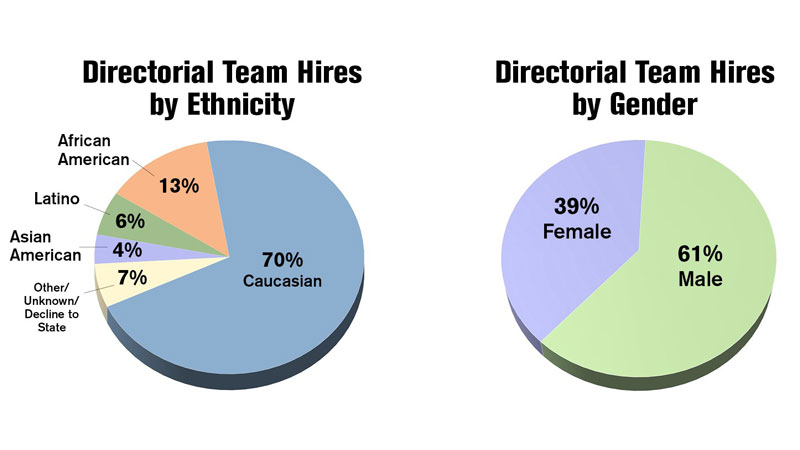
Gender and Ethnicity Breakdown:
465 of the directorial team jobs went to women, making up 39% of the total.
280 directorial team jobs went to directorial team members of color, making up 24% of the total. African Americans represented 13% of the jobs, Latinos represented 6%, Asian Americans 4% and Native Americans .6%.
A breakdown of the individual directorial team job categories by gender and ethnicity revealed the following:
- UPMs: 201 total jobs; 33% female; 11% people of color
- 1ADs: 338 total jobs; 31% female; 22% people of color
- 2ADs: 641 total jobs; 46% female; 29% people of color
The series and episodes analyzed were made under a DGA agreement by studios and production companies. The report analyzed the ethnicity and gender of directors hired to direct episodic television series across Broadcast, Basic Cable, Premium Cable, and Subscription Video on Demand (SVOD). Pilots are not included in the statistics. The DGA compiled the statistics in this report using internal information and information provided by production companies pursuant to the reporting requirements of its various collective bargaining agreements. All figures in this report are rounded to the nearest percentage or tenth of a percentage.
Future Reporting: The DGA began the process of identifying and tracking our LGBTQ and Disabled members in 2021 and will be looking to add inclusion statistics regarding both communities in future reporting.
The DGA has been pressing studios, networks, and producers to be more inclusive in hiring for nearly four decades. The Guild’s efforts include: collective bargaining gains requiring television studios to operate TV director diversity programs; ongoing meetings with studios, networks and individual series regarding their hiring records; and publicized reports detailing employer hiring patterns. In addition, the Guild itself has initiated a variety of TV director mentorship and educational programs to support the career development of its members.
For more information about the DGA’s diversity efforts, visit: /The-Guild/Diversity
APPENDIX
Appendix A – Director Hires Breakdown by Gender and Ethnicity and by Individual Director
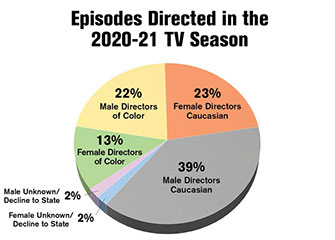
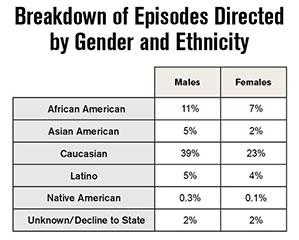
Individual Directors / Hiring Breakdown
There were 896 individual directors hired to work in the 2020-21 season. 39% were women and 61% were men. 15% were African American, 8% were Asian American, 64% were Caucasian, 9% were Latino, .02% were Native American, 4% were unknown/decline to state.
The report indicates that the percentages of episodes directed by women and directors of color align closely with the percentages of individual directors.
Appendix B – Hiring Data by Individual Series
For more information about the DGA’s diversity and inclusion efforts, visit: /The-Guild/Diversity
[1] In designing the parameters for this year’s report, the DGA made a change to its methodology and data collection to improve the overall accuracy of the report. A decision was made to remove one outlier from this year’s report. An African American director with up to 150 episodes annually inaccurately overstates the employment of African American directors. All data in the report comparing 2020-2021 to previous years has been adjusted so that statistics are comparable.
[2] This report tracks employment by television studios (production), as opposed to distribution platforms. Many studios also produce series for third parties, and some studios are not affiliated with a distribution platform.













